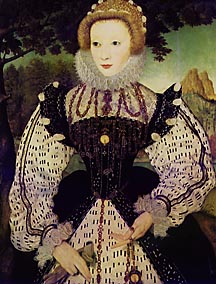
This exceedingly fashionable young Englishwoman is wearing a black gown with white sleeves and forepart decorated with black bars. Black as an overall color scheme for gowns, long popular in spanish fashion, only became internationally popularized during the last few decades of the 16th century.
This woman's sillhouette, which seems to modern eyes quite exaggerated, is a rather extreme example of the ideal Elizabethan female form. The shoulders are broadened by the shoulder rolls and large sleeves, while the waist is very narrow. This narrow-waisted look is partially an illusory result of the bodice point combined with the very wide and flaring pleated skirt, although it's true that some fashion victims of the time would lace their corsets tightly to achieve a smaller waist. (This practice doesn't seem to have been widespread, however.) She looks to be wearing what, in Elizabethan times, was referred to as a "french" or "strait-bodied" gown.
Wearing a bodice and overskirt of one color, combined with sleeves and underskirt of another color, was a common fashion motif in Elizabethan times. Many portraits show women wearing tight bodices and pleated overskirts, with elaborately embroidered or decorated matching sleeves and underskirts/foreparts. The general color scheme of these portraits seems to have the sleeves and underskirts a lighter color than the bodice and overskirt.
This woman's neck-ruff is wider than those shown in previous portraits, an example of the expansion which will continue through the end of the century. She also wears a complexly draped assembly of gold chains. This style of draping a necklace or chain and then catching it up with a brooch or pin to produce loops and swags was widely favored in elizabethan times. A large, ornate brooch was often pinned at the middle top of the bodice, catching a chain in the middle.
This woman's hair is completely uncovered, save for a small, decorative hood at the back. It is red, which was THE fashionable hair color, thanks to red-headed queen Elizabeth; it is also pulled back evenly from the face and puffed. Rolls were sometimes used to make hair puff out evenly around the face. In many ways, this girl's hairstyle is similar to the Queen's in the preceding Phoenix Portrait.
The girl's face, as well as her hair, clothing and shape, also echo the Elizabethan ideal. Her eyebrows are thin to nonexistant, her lips and features small and regular, and her skin exceedingly pale. White lead was often applied to the face to achieve this pale-skinned look. Ladies would also wash their faces with mercury-water to remove blemishes.
Next: Like Mother, Like Daughter